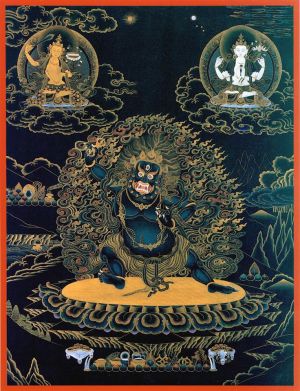The “Shambhala warrior” Chögyam Trungpa
In 1975 the Tibetan, Chögyam Trungpa (1940–1987), gathered several of his western pupils around himself and began to initiate them into a special spiritual discipline which he referred to as “Shambhala Training”. As a thirteen-month-old infant the Rinpoche from the Tibetan province of Kham was recognized as the tenth reincarnation of the Trungpa and accepted into the Kagyupa order. In 1959 he had to flee from the Chinese. In 1963 he traveled to England and studied western philosophy and comparative religion at Oxford. Like no other Tibetan lama of his time, he understood how to make his own contribution to western civilization and culture. As a brilliant rhetorician, poet, and exotic free spirit he soon found numerous enthusiastic listeners and followers. In 1967 he founded the first European tantric monastery in Scotland. He gave it the name and the ground-plan of Samye Ling — in remembrance of the inaugural Tibetan shrine of the same name that Padmasambhava erected at the end of the 8th century despite resistance from countless demons. In the opinion of Trungpa’s followers the demonic resistance was enormous in Scotland too. In 1969 the young lama was the victim of a serious car accident which left him with a permanent limp. There is an ambiguous anecdote about this unfortunate event. Trungpa had reached a fork in the road in his car — to the right the road led in the direction of his monastery, the road to the left to the house in which his future wife lived. But he continued to drive straight ahead, plowing right into a shop selling magic and joke articles. Nevertheless, his meteoric rise had begun. In 1970 he went to the United States. Trungpa’s charming and initially anarchic manner, his humor and loyalty, his lack of respect and his laugh magnetically attracted many young people from the sixties generation. They believed that here the sweet but dangerous mixture of the exotic, social critique, free love, mind-expanding drugs, spirituality, political activism and self-discovery, which they had tasted in the revolutionary years of their youth, could be rediscovered. Trungpa’s friendship with the radical beatnik poet Allan Ginsberg and other well-known American poets further enhanced his image as a “wild boy” from the roof of world. Even the first monastery he founded, Samye Ling, was renowned for the permissive “spiritual” parties which were held there and for the liberal sex and drug consumption. But such excesses are only one side of things. Via the tantric law of inversion Trungpa intended to ultimately transform all this abandon (his own and that of his pupils) into discipline, goodness, and enlightened consciousness. The success of the guru was boundless. Many thousands cam to him as pilgrims. All over America and Europe spiritual centers (dharmadhatus) were created. The Naropa Institute (near Denver, Colorado) was established as a private university, where alongside various Buddhist disciplines fine arts could also be studied.
